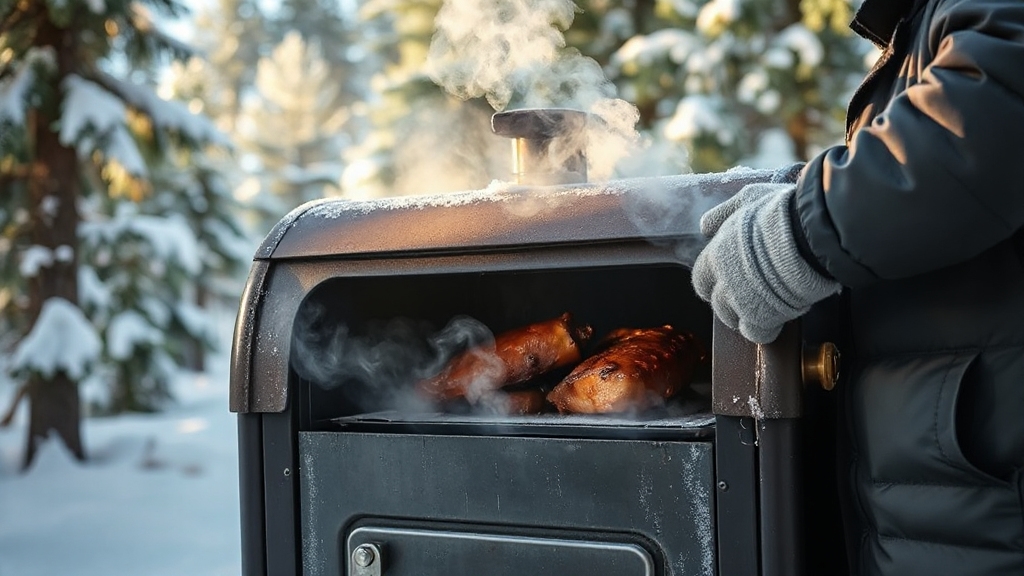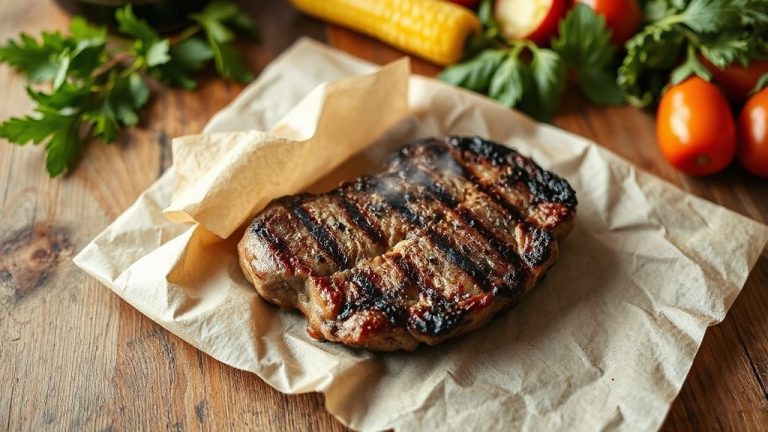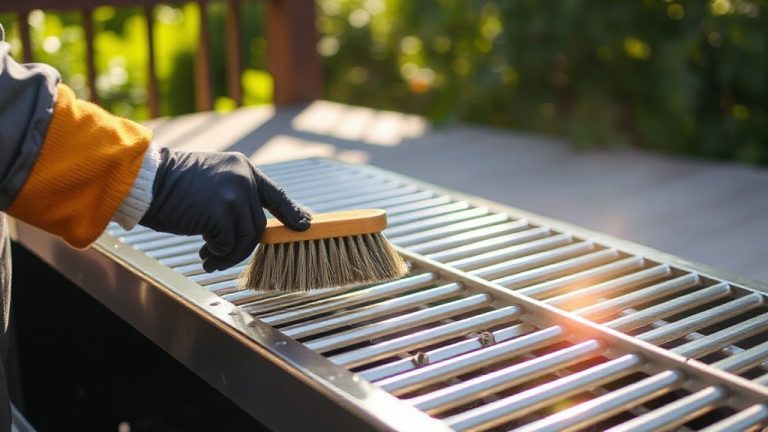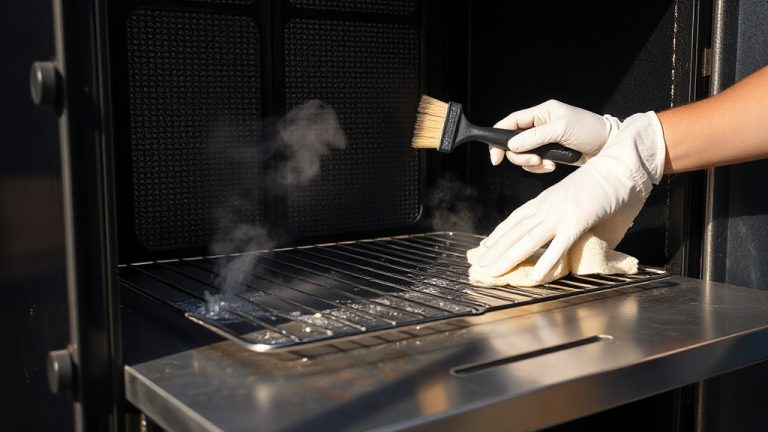Can You Smoke Meat in Cold Weather? Things to Know
You can definitely smoke meat in cold weather, but you’ll need to manage heat loss carefully. Insulating your smoker with jackets or blankets, sealing gaps, and using thicker walls helps maintain consistent temperatures despite the cold.
Wind can cause temperature fluctuations, so positioning your smoker properly and adding windbreaks is essential. Expect longer cooking times and increased fuel use, making temperature monitoring vital.
If you want to optimize your cold-weather smoking technique, there’s more to explore about equipment and adjustments.
Key Takeaways
- Yes, you can smoke meat in cold weather with proper insulation and wind protection to maintain stable smoker temperatures.
- Use smoker jackets, blankets, or insulated models to reduce heat loss and improve fuel efficiency in cold conditions.
- Position the smoker away from wind and snow, using windbreaks or screens to prevent rapid temperature fluctuations.
- Expect longer cooking times and increased fuel consumption; preheat fully and monitor temperatures frequently with multiple probes.
- Maintain safety by clearing snow from the area, sealing joints to prevent moisture intrusion, and practicing proper hygiene during extended sessions.
How Cold Weather Affects Smoking Performance?
When you smoke meat in cold weather, the performance of your smoker changes markedly due to heat loss and environmental factors.
Thicker smoker walls and proper insulation become critical, as they help retain heat and maintain stable internal temperatures. The material composition of your smoker also influences heat retention; metal smokers lose heat faster than those with insulated walls.
Additionally, using smoker jackets or blankets can greatly improve heat retention and fuel efficiency in cold conditions.
Airflow control is essential—you need to adjust vents to counteract wind, which can rapidly cool the smoker’s interior. Without these adjustments, you’ll face challenges maintaining consistent temperatures, directly affecting cooking times and smoke quality.
Maintaining a consistent temperature is key, as uneven heat can impact both the safety and moisture retention of the meat. Even covered grills used as alternatives require careful management of heat and airflow.
Managing Heat Loss in Low Temperatures
You’ll need to insulate your smoker effectively to reduce heat loss and maintain consistent temperatures in cold weather.
Insulation Techniques
Although cold weather poses significant challenges to maintaining stable smoker temperatures, applying effective insulation techniques can markedly reduce heat loss and improve cooking consistency.
You can use fire-resistant materials like welder’s blankets or furnace insulation to wrap around your smoker, blocking heat loss through its walls without risking ignition.
Since cold weather increases fuel consumption, having a larger or full tank of fuel ready helps maintain consistent heat throughout the cooking process.
Smoker jackets provide a tailored fit that minimizes thermal escape, but be sure to keep vents and firebox areas uncovered to maintain proper airflow and combustion.
Positioning your smoker away from wind and utilizing DIY insulation from hardware store materials also helps conserve heat.
Fuel Consumption Strategies
Insulating your smoker reduces heat loss, but colder temperatures still demand more fuel to maintain consistent cooking conditions. You’ll find that wood, charcoal, and pellets all require increased consumption to offset heat loss.
Stock ample fuel beforehand to avoid interruptions. Electric smokers offer a stable heat source, using wood chips for flavor. Position your smoker away from wind and clear snow to minimize additional heat loss.
Using an insulated jacket or blanket around the smoker can help maintain a consistent internal temperature by reducing cold air infiltration and heat loss, improving fuel efficiency in cold weather temperature stability.
Wrapping and insulating also play a key role in retaining heat, similar to how a brisket should be rested in a preheated cooler to maintain proper temperature and moisture.
| Fuel Type | Cold Weather Impact |
|---|---|
| Wood | Increased consumption |
| Charcoal | Requires more frequent refueling |
| Pellets | Higher burn rates |
| Electric | Stable heat with power use |
| Stocking Fuel | Essential for uninterrupted cooking |
Choosing the Right Smoker for Winter Smoking
When selecting a smoker for winter smoking, you must prioritize features that guarantee consistent heat and fuel efficiency despite cold conditions.
Pellet smokers excel here, thanks to automatic temperature control and good insulation, maintaining steady heat with minimal fuel. However, keep in mind that pellet grills are moisture-sensitive, so it’s important to store pellets properly to prevent dampness that can affect ignition and performance.
Additionally, maintaining a consistent low and steady temperature is crucial for maximizing flavor and efficiency in cold weather. Electric smokers with solid insulation and digital controls offer precise temperature management, simplifying operation in cold weather.
Avoid offset and bullet smokers, as they require constant manual adjustments, which is impractical in winter.
Focus on models constructed with durable materials that resist moisture and cold. Brands like Masterbuilt, Rec Teq, and Cookshack provide reliable options designed for low temperatures.
Techniques for Insulating and Protecting Your Smoker
You’ll want to insulate your smoker with fire-resistant materials like welding blankets or custom jackets to retain heat and reduce fuel use.
Proper insulation reduces fuel consumption and enhances efficiency in cold weather. Positioning windbreaks or using sheltered areas also helps minimize temperature fluctuations caused by cold winds.
Maintaining airflow by keeping vents clear is vital to guarantee safety and consistent cooking performance. Using proper airflow management allows better temperature control and burn rate adjustment in cold conditions.
Ensure proper ventilation, especially in enclosed or semi-enclosed areas, to avoid carbon monoxide buildup.
Smoker Insulation Options
Although cold weather poses challenges for maintaining stable smoker temperatures, effectively insulating your smoker can considerably improve heat retention and fuel efficiency.
Custom smoker jackets, tailored for models like Weber, provide a snug, silicone-coated weather-resistant barrier that preserves heat and withstands rain and wind.
If you need flexibility, universal smoker blankets offer adaptable insulation, though may sacrifice fit. For DIY approaches, fireproof welder’s blankets and double foil insulation reflect heat effectively but require careful vent clearance to maintain airflow and safety.
Using seasoned hardwoods for smoking can complement insulation efforts by producing cleaner smoke and maintaining flavor integrity in cold conditions.
Enhancing heat retention internally with bricks or metal plates further stabilizes temperature and reduces fuel consumption. Prioritize fireproof, weather-resistant materials that allow easy installation and access to vents and gauges.
Cold air increases heat loss so proper insulation is essential to ensure your smoker maintains consistent temperatures. Regularly inspect your insulation for wear to guarantee consistent performance and safety during cold-weather smoking.
Wind and Weather Shields
Since wind can drastically affect temperature stability and smoke flow, implementing effective wind and weather shields becomes essential for consistent smoking results.
Position your smoker’s intake facing the prevailing wind to stabilize airflow, and use natural barriers or constructed wind screens to block gusts without restricting ventilation.
It is important to note that wind whipping around the cooker can alter heat consistency and cause temperature swings. Using cast iron skillets can also help maintain steady heat when searing smoked meats in cold weather.
Adjustable, foldable screens with heat-resistant materials offer adaptable protection while preventing heat damage. Monitor wind patterns and adjust dampers to maintain temperature control. Here’s a quick guide to key wind shield strategies:
| Technique | Material Options | Key Considerations |
|---|---|---|
| Align smoker intake | N/A | Face prevailing wind |
| Wind screens | Wood, metal, sheathing | Height > smoker, clearance |
| Portable screens | Metal folding, pop-up | Adjustable, foldable |
| Dampers adjustment | N/A | Close more in wind |
| Fuel management | Larger fuel pieces | Longer combustion times |
Impact of Wind and Weather Conditions on Smoking
When wind interacts with your smoker, it dramatically increases heat loss, forcing you to use more fuel and extend cooking times to maintain consistent temperatures.
Cold winds cause rapid temperature fluctuations inside the smoker, undermining heat stability and affecting meat quality.
Cold weather does not inherently affect the smoking process if monitored properly, so consistent internal temperature control is key to quality results regardless of outside conditions.
Positioning your smoker in a sheltered area or behind windbreaks like cinder blocks minimizes these effects by reducing airflow and conserving heat.
Additionally, cold ambient temperatures demand more energy to keep internal temperatures steady, making insulated or ceramic smokers more effective due to superior heat retention.
Sheltering your smoker and choosing insulated models helps conserve heat and maintain steady cooking temperatures in cold weather.
Snow and ice around the smoker impede operation, so clearing them is essential. High moisture levels from cold weather can alter smoke absorption, while regular equipment maintenance is necessary to prevent cold-related wear.
Adjusting Cooking Times and Temperature Monitoring
Because cold weather considerably slows heat recovery and increases cooking times, you’ll need to adjust your smoking schedule accordingly.
Expect cooking times to increase by three hours or more, sometimes even doubling in extreme cold. Use a reliable probe thermometer to monitor both smoker and meat temperatures closely. Avoid relying on standard time charts; instead, base decisions on real-time data.
To optimize your smoking process in cold weather:
- Preheat your smoker fully before adding meat, allowing extra time for this step.
- Monitor temperatures at multiple points to detect heat gradients and adjust meat placement.
- Check temperatures more frequently to prevent undercooking due to heat loss. Remember, use temperature as the primary indicator for doneness rather than time alone.
- Schedule a buffer for extended cooking times, considering slower heat recovery after opening the smoker.
Fuel Consumption and Combustion Challenges in Cold Weather
Although cold weather poses significant challenges, understanding fuel consumption and combustion dynamics is essential for maintaining consistent smoker temperatures.
You’ll need more fuel as cold ambient temperatures and frequent lid openings increase heat loss. Lighter smoker materials exacerbate this by dissipating heat faster, demanding careful fuel management and insulation use.
Propane’s higher energy density and heat output can be advantageous in cold conditions for efficient heating. Wind and precipitation further disrupt combustion efficiency, making continuous temperature monitoring critical.
Grilla Grills offers innovative grilling solutions designed to maintain heat efficiently, which can be particularly beneficial in cold conditions by enhancing fuel management.
| Challenge | Impact on Smoking | Your Action |
|---|---|---|
| Increased Fuel Use | Faster burn rate | Stock ample high-quality fuel |
| Heat Loss | Temperature drops | Insulate smoker or use thermal jackets |
| Wind & Moisture | Combustion instability | Shield smoker from elements |
| Lid Opening | Heat fluctuations | Minimize lid openings |
Safety Considerations When Smoking in Winter
Managing fuel and temperature in cold weather directly influences the safety of your smoking process. You must avoid the bacterial danger zone between 40°F and 140°F by carefully controlling smoker and meat temperatures with dual thermometers. Maintaining a steady smoker temperature is crucial to ensure even cooking and food safety.
Carefully control smoker and meat temperatures to avoid the bacterial danger zone in cold weather smoking.
Here are four key safety considerations:
- Fully thaw meat and use proven curing methods to inhibit bacterial growth before smoking.
- Sanitize equipment thoroughly and store fuel dry to prevent contamination and maintain clean combustion. It is also important to manage fuel carefully since cold weather increases pellet consumption.
- Monitor weather closely; wind can cause temperature fluctuations that increase risk. Using a water pan can help stabilize heat and humidity inside the smoker.
- After smoking, cool meat rapidly and refrigerate within two hours to prevent pathogens like Clostridium botulinum from multiplying.
Tips for Successful Cold Weather Smoking Sessions
When you smoke meat in cold weather, careful preparation and precise temperature control become critical to success. Start by clearing the smoking area of snow and debris to ensure safety and prevent contamination.
Use an insulated or ceramic smoker, positioned away from wind and snow-laden branches to maintain heat stability. To maintain temperature and conserve fuel, consider using a smoker jacket or blanket to insulate your smoker.
Proper sealing and storage of your wood chips also help preserve their moisture and flavor for the best smoke quality.
Preheat your smoker twice as long and employ a multi-probe thermometer to monitor temperatures accurately. Insulate the smoker with blankets and adjust vents to control airflow, combating cold air intrusion.
Expect higher fuel consumption, stock dense hardwoods and check fuel levels frequently. Using dense hardwoods not only provides longer burn times but also contributes to the signature smoky aroma essential for great barbecue.
Choose leaner cuts for faster, more efficient cooking, and monitor internal meat temperatures closely. Finally, create windbreaks as needed and keep the smoker lid closed to optimize heat retention and consistent smoke flow throughout your session.
Always use clean utensils and maintain proper hygiene when handling meat to ensure food safety during longer cold weather cooks.
Frequently Asked Questions
Can Smoking Meat in Cold Weather Enhance Flavor Profiles?
You might expect cold weather to boost smoked meat’s flavor, but evidence shows it doesn’t inherently enhance flavor profiles. While colder air slows combustion and can cause smoke to linger longer, this can lead to bitter creosote buildup if not managed carefully.
Instead, focus on using quality wood and maintaining proper airflow. Flavor depends more on these factors than ambient temperature, so precise temperature control and technique are your best tools.
Does Cold Weather Affect the Texture of Smoked Meat?
Cold weather itself doesn’t directly change smoked meat’s texture, but it can affect how you maintain consistent smoker temperatures. If you manage heat well, longer cooking times can actually improve tenderness by breaking down collagen in tougher cuts.
However, temperature fluctuations risk uneven texture. You should preheat thoroughly, minimize lid openings, and use insulation or remote thermometers to keep steady heat, ensuring your meat stays tender and juicy regardless of cold conditions.
What Types of Wood Chips Are Best for Winter Smoking?
Imagine the steady burn of oak chunks versus the quick flare of mesquite chips. For winter smoking, you want hardwoods like oak, hickory, or maple because they burn consistently in cold air.
Fruitwoods like apple or cherry add mild sweetness without overpowering flavors. Avoid wet wood and use larger, dry chunks for stable heat.
Combining wood types balances flavor while preheating chips helps maintain combustion efficiency in low temperatures.
Can You Use Electric Smokers Effectively in Freezing Temperatures?
You can use electric smokers effectively in freezing temperatures, but you’ll need to modify your approach. Preheat the smoker thoroughly, even using hot water in the water pan to boost internal heat.
Insulate or shelter your smoker to minimize heat loss and protect electronic components from moisture. Expect longer smoking times and increased fuel consumption due to cold metal absorbing heat. Regularly monitor temperatures to maintain consistency and ensure safe operation in harsh weather.
How Does Altitude Combined With Cold Weather Affect Smoking Times?
When smoking at high altitude combined with cold weather, you’ll notice longer cooking times and more frequent temperature fluctuations.
Lower oxygen levels reduce combustion efficiency, requiring more fuel and careful air intake adjustments. The cold increases heat loss, so you’ll need to monitor temperatures closely and refuel often.
Expect overall smoke time to increase markedly, and use a water pan to maintain moisture, as evaporation rates rise in these conditions.
Master the Cold: Smoke Smarter, Not Harder in the Winter
You might think cold weather puts a hard stop on smoking meat, but with the right strategies, it doesn’t have to. Insulating your smoker, managing heat loss, and adjusting fuel use are critical—and overlooking even one can derail your cook.
As temperatures drop, subtle shifts in technique become essential. Will you adapt and master winter smoking, or let the cold compromise your results? The answer lies in your preparation and attention to detail.






